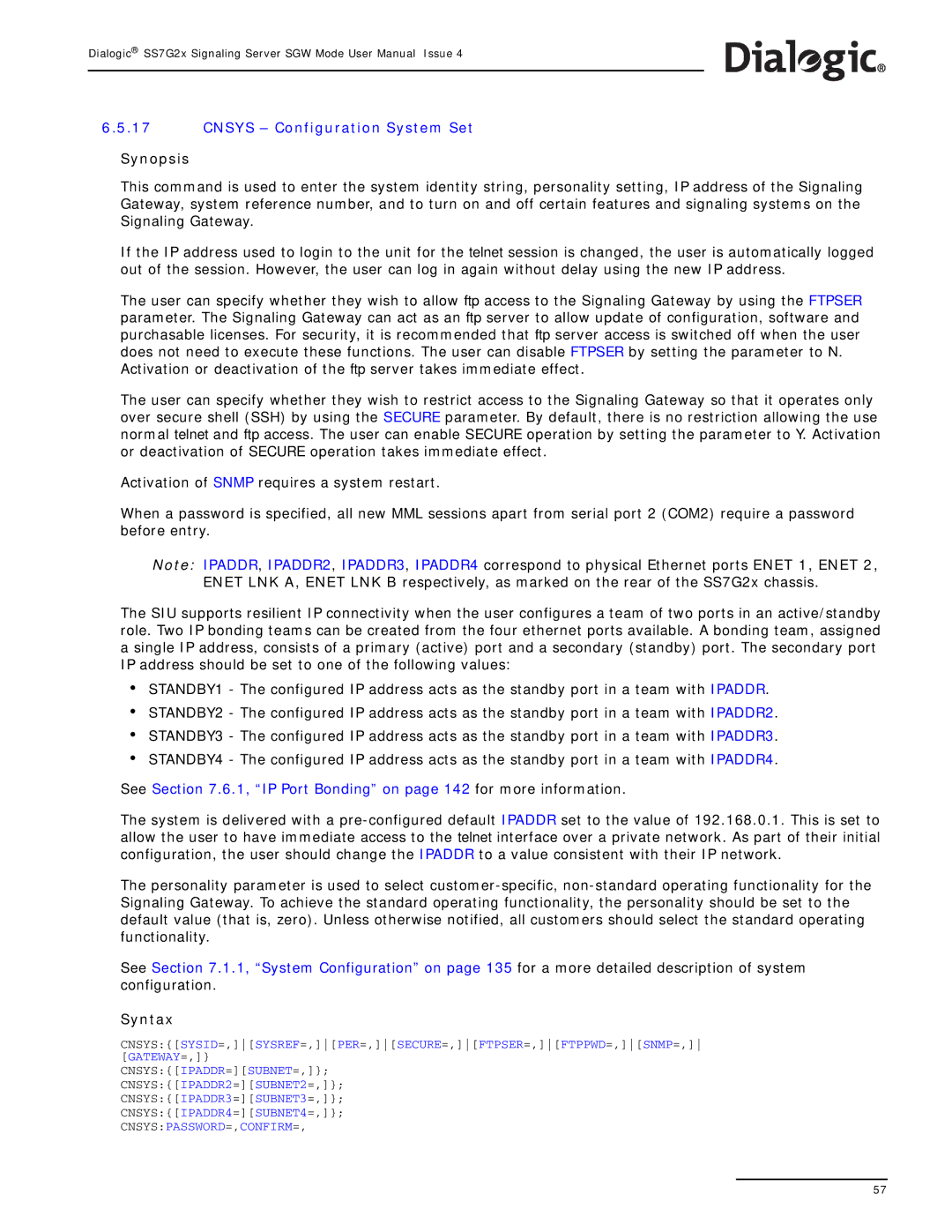
Dialogic® SS7G2x Signaling Server SGW Mode User Manual Issue 4
6.5.17CNSYS – Configuration System Set
Synopsis
This command is used to enter the system identity string, personality setting, IP address of the Signaling Gateway, system reference number, and to turn on and off certain features and signaling systems on the Signaling Gateway.
If the IP address used to login to the unit for the telnet session is changed, the user is automatically logged out of the session. However, the user can log in again without delay using the new IP address.
The user can specify whether they wish to allow ftp access to the Signaling Gateway by using the FTPSER parameter. The Signaling Gateway can act as an ftp server to allow update of configuration, software and purchasable licenses. For security, it is recommended that ftp server access is switched off when the user does not need to execute these functions. The user can disable FTPSER by setting the parameter to N.
Activation or deactivation of the ftp server takes immediate effect.
The user can specify whether they wish to restrict access to the Signaling Gateway so that it operates only over secure shell (SSH) by using the SECURE parameter. By default, there is no restriction allowing the use normal telnet and ftp access. The user can enable SECURE operation by setting the parameter to Y. Activation or deactivation of SECURE operation takes immediate effect.
Activation of SNMP requires a system restart.
When a password is specified, all new MML sessions apart from serial port 2 (COM2) require a password before entry.
Note: IPADDR, IPADDR2, IPADDR3, IPADDR4 correspond to physical Ethernet ports ENET 1, ENET 2, ENET LNK A, ENET LNK B respectively, as marked on the rear of the SS7G2x chassis.
The SIU supports resilient IP connectivity when the user configures a team of two ports in an active/standby role. Two IP bonding teams can be created from the four ethernet ports available. A bonding team, assigned a single IP address, consists of a primary (active) port and a secondary (standby) port. The secondary port IP address should be set to one of the following values:
•
•
•
•
STANDBY1 - The configured IP address acts as the standby port in a team with IPADDR. STANDBY2 - The configured IP address acts as the standby port in a team with IPADDR2. STANDBY3 - The configured IP address acts as the standby port in a team with IPADDR3. STANDBY4 - The configured IP address acts as the standby port in a team with IPADDR4.
See Section 7.6.1, “IP Port Bonding” on page 142 for more information.
The system is delivered with a
The personality parameter is used to select
See Section 7.1.1, “System Configuration” on page 135 for a more detailed description of system configuration.
Syntax
CNSYS:{[SYSID=,][SYSREF=,][PER=,][SECURE=,][FTPSER=,][FTPPWD=,][SNMP=,] [GATEWAY=,]}
CNSYS:{[IPADDR=][SUBNET=,]}; CNSYS:{[IPADDR2=][SUBNET2=,]}; CNSYS:{[IPADDR3=][SUBNET3=,]}; CNSYS:{[IPADDR4=][SUBNET4=,]}; CNSYS:PASSWORD=,CONFIRM=,
57
